fuel TOYOTA LAND CRUISER 2013 J200 Owner's Guide
[x] Cancel search | Manufacturer: TOYOTA, Model Year: 2013, Model line: LAND CRUISER, Model: TOYOTA LAND CRUISER 2013 J200Pages: 720, PDF Size: 21.46 MB
Page 610 of 720
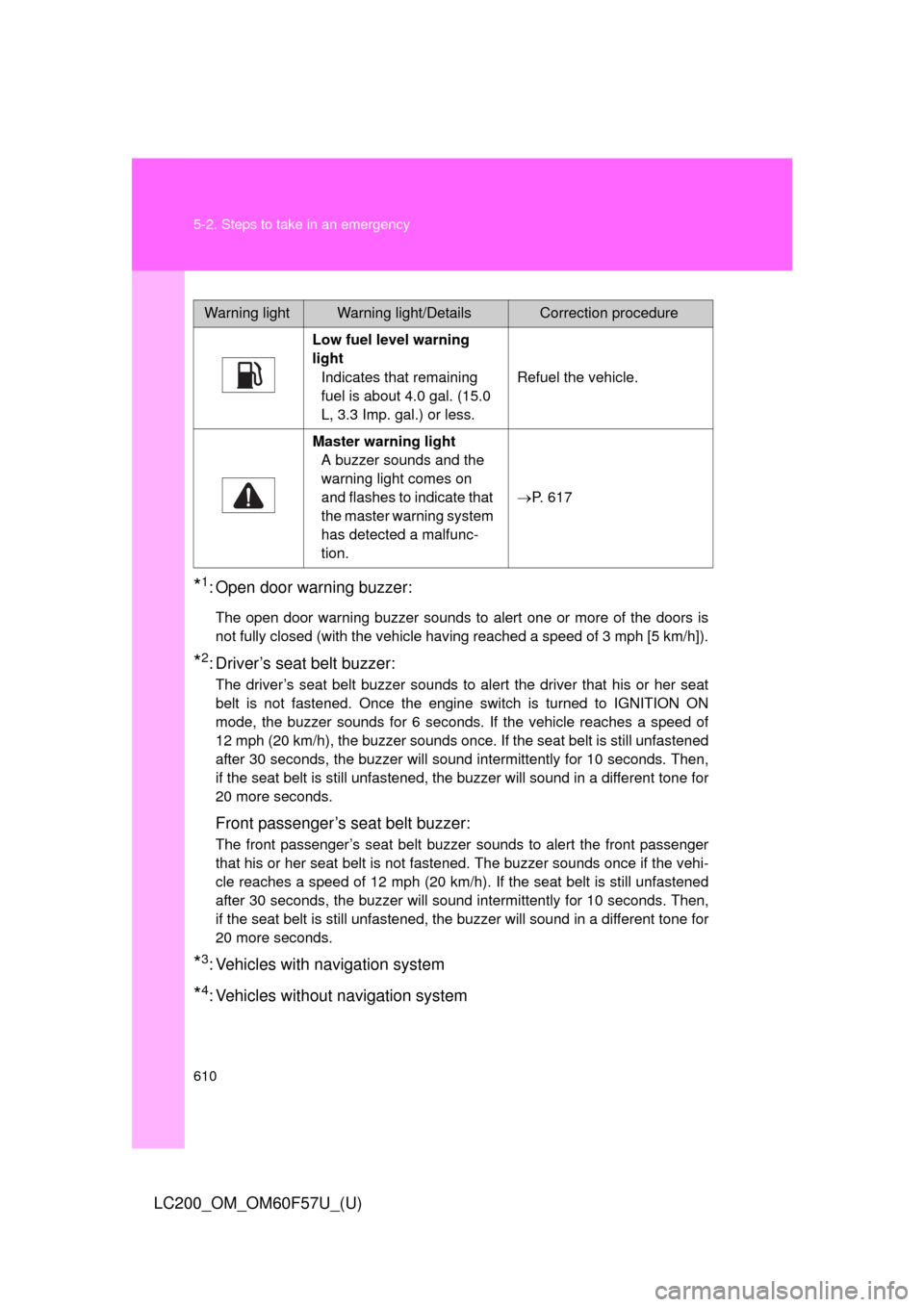
610 5-2. Steps to take in an emergency
LC200_OM_OM60F57U_(U)
*1: Open door warning buzzer:
The open door warning buzzer sounds to alert one or more of the doors is
not fully closed (with the vehicle having reached a speed of 3 mph [5 km/h]).
*2: Driver’s seat belt buzzer:
The driver’s seat belt buzzer sounds to alert the driver that his or her seat
belt is not fastened. Once the engine switch is turned to IGNITION ON
mode, the buzzer sounds for 6 seconds. If the vehicle reaches a speed of
12 mph (20 km/h), the buzzer sounds once. If the seat belt is still unfastened
after 30 seconds, the buzzer will sound intermittently for 10 seconds. Then,
if the seat belt is still unfastened, the buzzer will sound in a different tone for
20 more seconds.
Front passenger’s seat belt buzzer:
The front passenger’s seat belt buzzer sounds to alert the front passenger
that his or her seat belt is not fastened. The buzzer sounds once if the vehi-
cle reaches a speed of 12 mph (20 km/h). If the seat belt is still unfastened
after 30 seconds, the buzzer will sound intermittently for 10 seconds. Then,
if the seat belt is still unfastened, the buzzer will sound in a different tone for
20 more seconds.
*3: Vehicles with navigation system
*4: Vehicles without navigation system
Warning lightWarning light/DetailsCorrection procedure
Low fuel level warning
light
Indicates that remaining
fuel is about 4.0 gal. (15.0
L, 3.3 Imp. gal.) or less.Refuel the vehicle.
Master warning light
A buzzer sounds and the
warning light comes on
and flashes to indicate that
the master warning system
has detected a malfunc-
tion.P. 617
Page 611 of 720
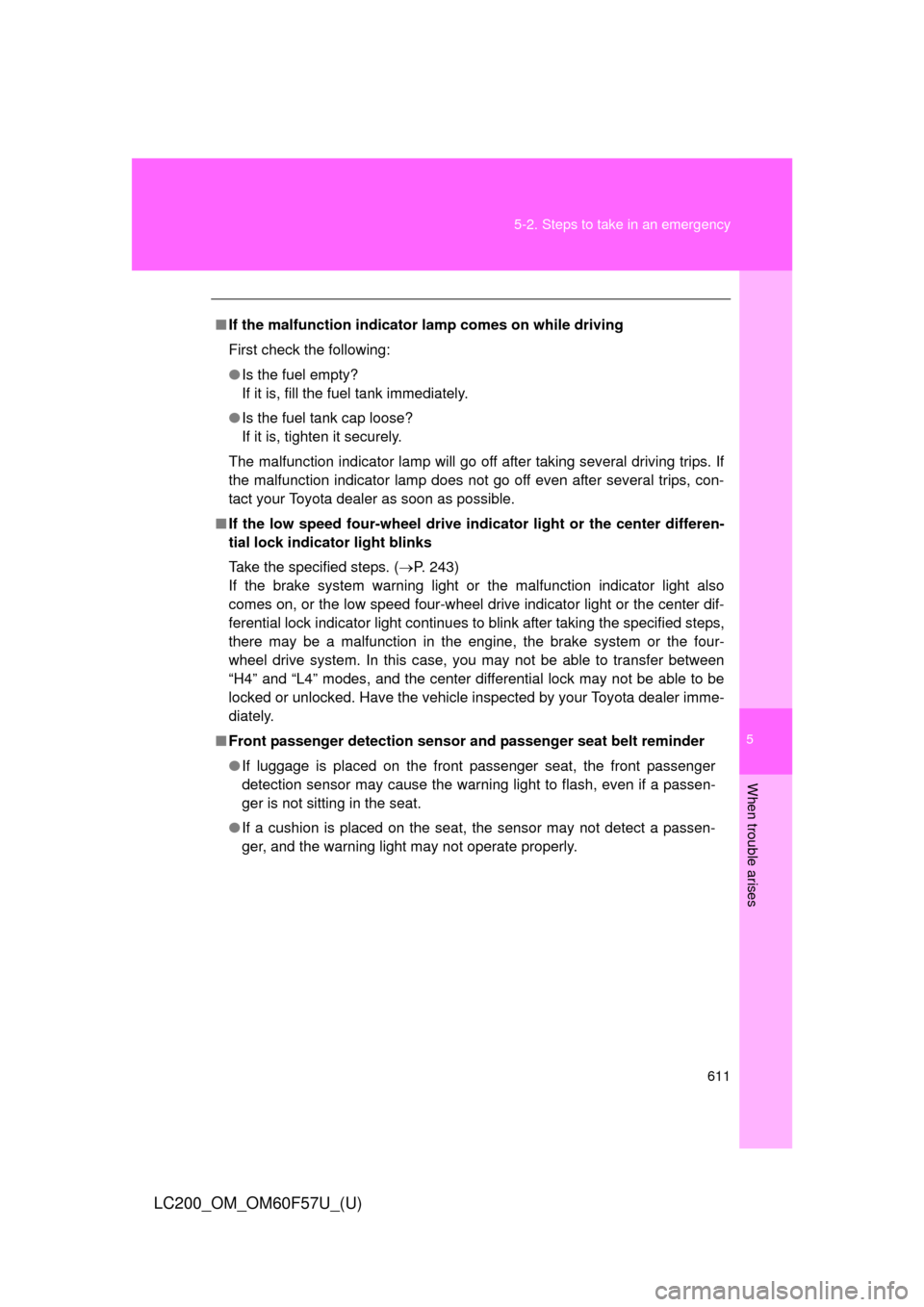
5
When trouble arises
611 5-2. Steps to take in an emergency
LC200_OM_OM60F57U_(U)
■If the malfunction indicator lamp comes on while driving
First check the following:
●Is the fuel empty?
If it is, fill the fuel tank immediately.
●Is the fuel tank cap loose?
If it is, tighten it securely.
The malfunction indicator lamp will go off after taking several driving trips. If
the malfunction indicator lamp does not go off even after several trips, con-
tact your Toyota dealer as soon as possible.
■If the low speed four-wheel drive indicator light or the center differen-
tial lock indicator light blinks
Take the specified steps. (P. 243)
If the brake system warning light or the malfunction indicator light also
comes on, or the low speed four-wheel drive indicator light or the center dif-
ferential lock indicator light continues to blink after taking the specified steps,
there may be a malfunction in the engine, the brake system or the four-
wheel drive system. In this case, you may not be able to transfer between
“H4” and “L4” modes, and the center differential lock may not be able to be
locked or unlocked. Have the vehicle inspected by your Toyota dealer imme-
diately.
■Front passenger detection sensor and passenger seat belt reminder
●If luggage is placed on the front passenger seat, the front passenger
detection sensor may cause the warning light to flash, even if a passen-
ger is not sitting in the seat.
●If a cushion is placed on the seat, the sensor may not detect a passen-
ger, and the warning light may not operate properly.
Page 615 of 720
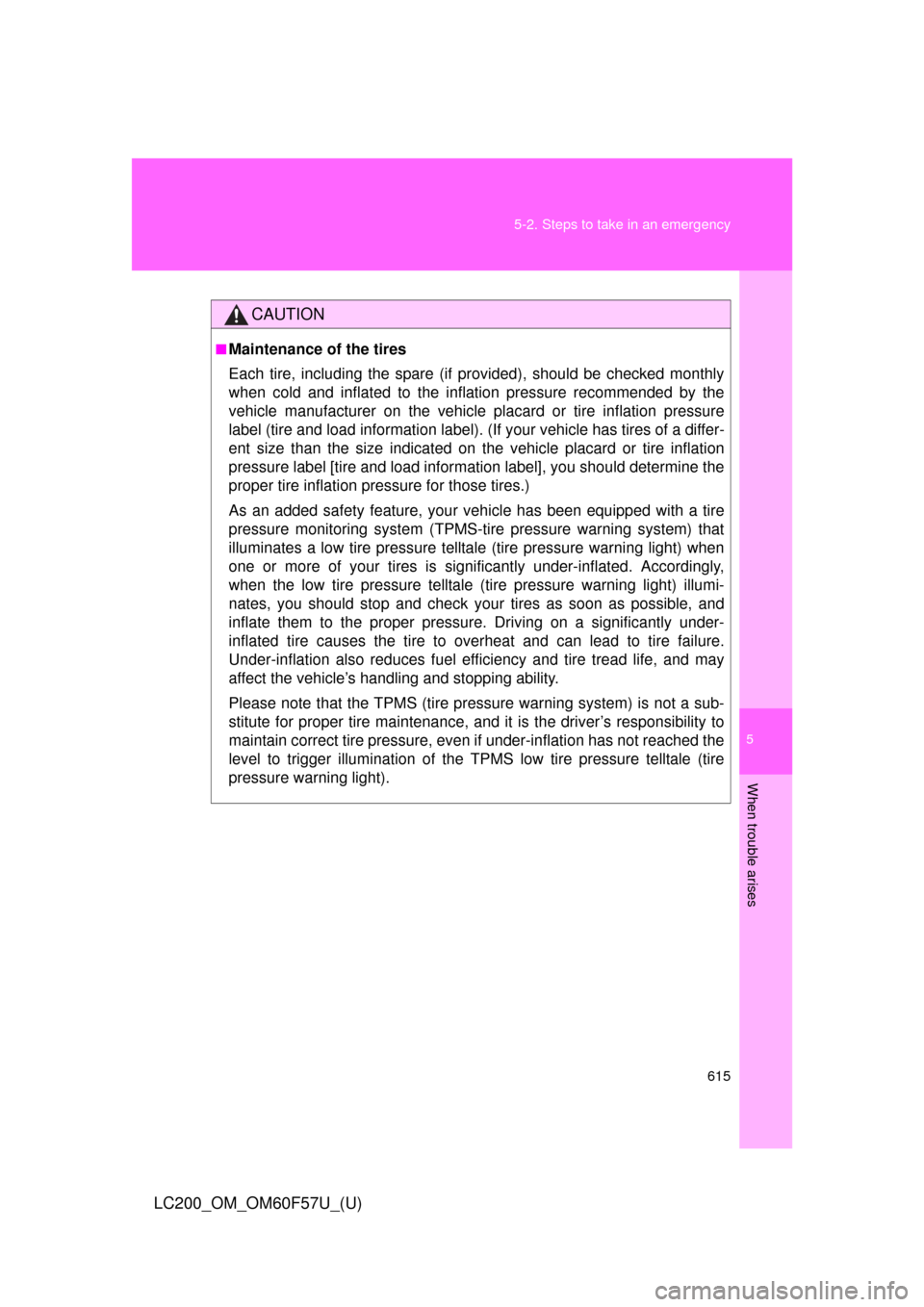
5
When trouble arises
615 5-2. Steps to take in an emergency
LC200_OM_OM60F57U_(U)
CAUTION
■Maintenance of the tires
Each tire, including the spare (if provided), should be checked monthly
when cold and inflated to the inflation pressure recommended by the
vehicle manufacturer on the vehicle placard or tire inflation pressure
label (tire and load information label). (If your vehicle has tires of a differ-
ent size than the size indicated on the vehicle placard or tire inflation
pressure label [tire and load information label], you should determine the
proper tire inflation pressure for those tires.)
As an added safety feature, your vehicle has been equipped with a tire
pressure monitoring system (TPMS-tire pressure warning system) that
illuminates a low tire pressure telltale (tire pressure warning light) when
one or more of your tires is significantly under-inflated. Accordingly,
when the low tire pressure telltale (tire pressure warning light) illumi-
nates, you should stop and check your tires as soon as possible, and
inflate them to the proper pressure. Driving on a significantly under-
inflated tire causes the tire to overheat and can lead to tire failure.
Under-inflation also reduces fuel efficiency and tire tread life, and may
affect the vehicle’s handling and stopping ability.
Please note that the TPMS (tire pressure warning system) is not a sub-
stitute for proper tire maintenance, and it is the driver’s responsibility to
maintain correct tire pressure, even if under-inflation has not reached the
level to trigger illumination of the TPMS low tire pressure telltale (tire
pressure warning light).
Page 624 of 720
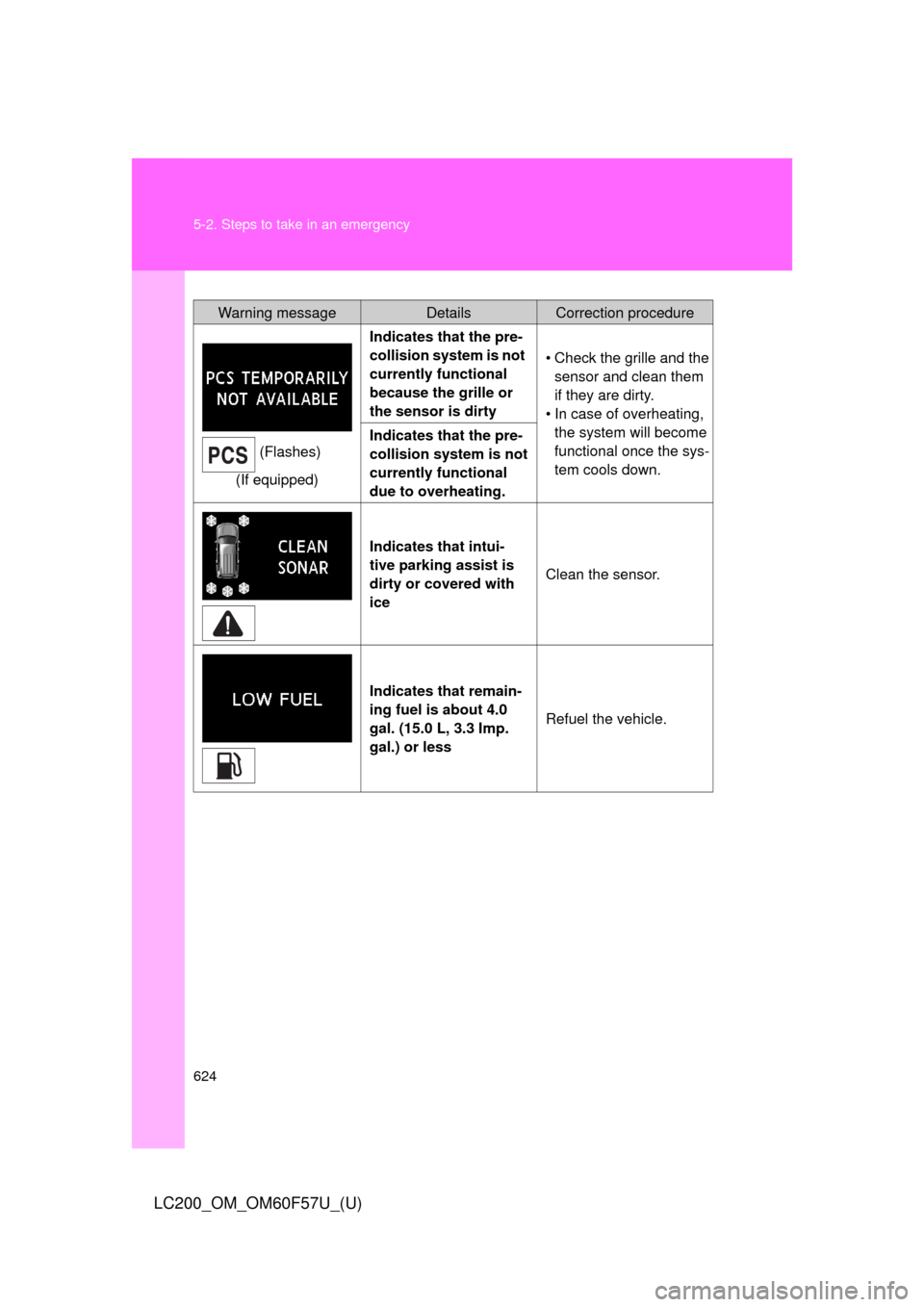
624 5-2. Steps to take in an emergency
LC200_OM_OM60F57U_(U)
Warning messageDetailsCorrection procedure
(Flashes)
(If equipped)Indicates that the pre-
collision system is not
currently functional
because the grille or
the sensor is dirty• Check the grille and the
sensor and clean them
if they are dirty.
• In case of overheating,
the system will become
functional once the sys-
tem cools down. Indicates that the pre-
collision system is not
currently functional
due to overheating.
Indicates that intui-
tive parking assist is
dirty or covered with
iceClean the sensor.
Indicates that remain-
ing fuel is about 4.0
gal. (15.0 L, 3.3 Imp.
gal.) or less Refuel the vehicle.
Page 647 of 720
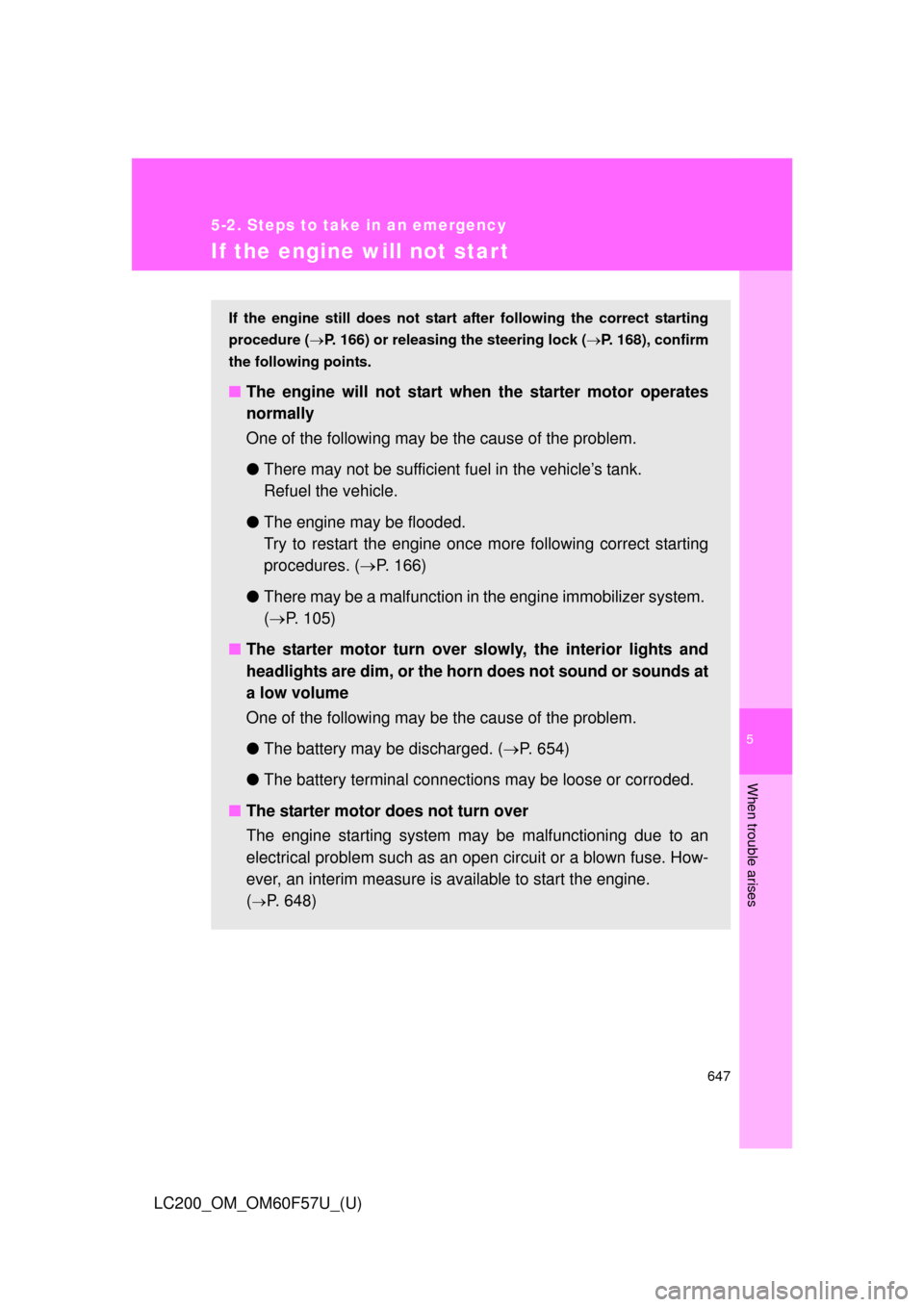
5
When trouble arises
647
5-2. Steps to take in an emergency
LC200_OM_OM60F57U_(U)
If the engine will not star t
If the engine still does not start after following the correct starting
procedure (P. 166) or releasing the steering lock (P. 168), confirm
the following points.
■The engine will not start when the starter motor operates
normally
One of the following may be the cause of the problem.
●There may not be sufficient fuel in the vehicle’s tank.
Refuel the vehicle.
●The engine may be flooded.
Try to restart the engine once more following correct starting
procedures. (P. 166)
●There may be a malfunction in the engine immobilizer system.
(P. 105)
■The starter motor turn over slowly, the interior lights and
headlights are dim, or the horn does not sound or sounds at
a low volume
One of the following may be the cause of the problem.
●The battery may be discharged. (P. 654)
●The battery terminal connections may be loose or corroded.
■The starter motor does not turn over
The engine starting system may be malfunctioning due to an
electrical problem such as an open circuit or a blown fuse. How-
ever, an interim measure is available to start the engine.
(
P. 648)
Page 665 of 720
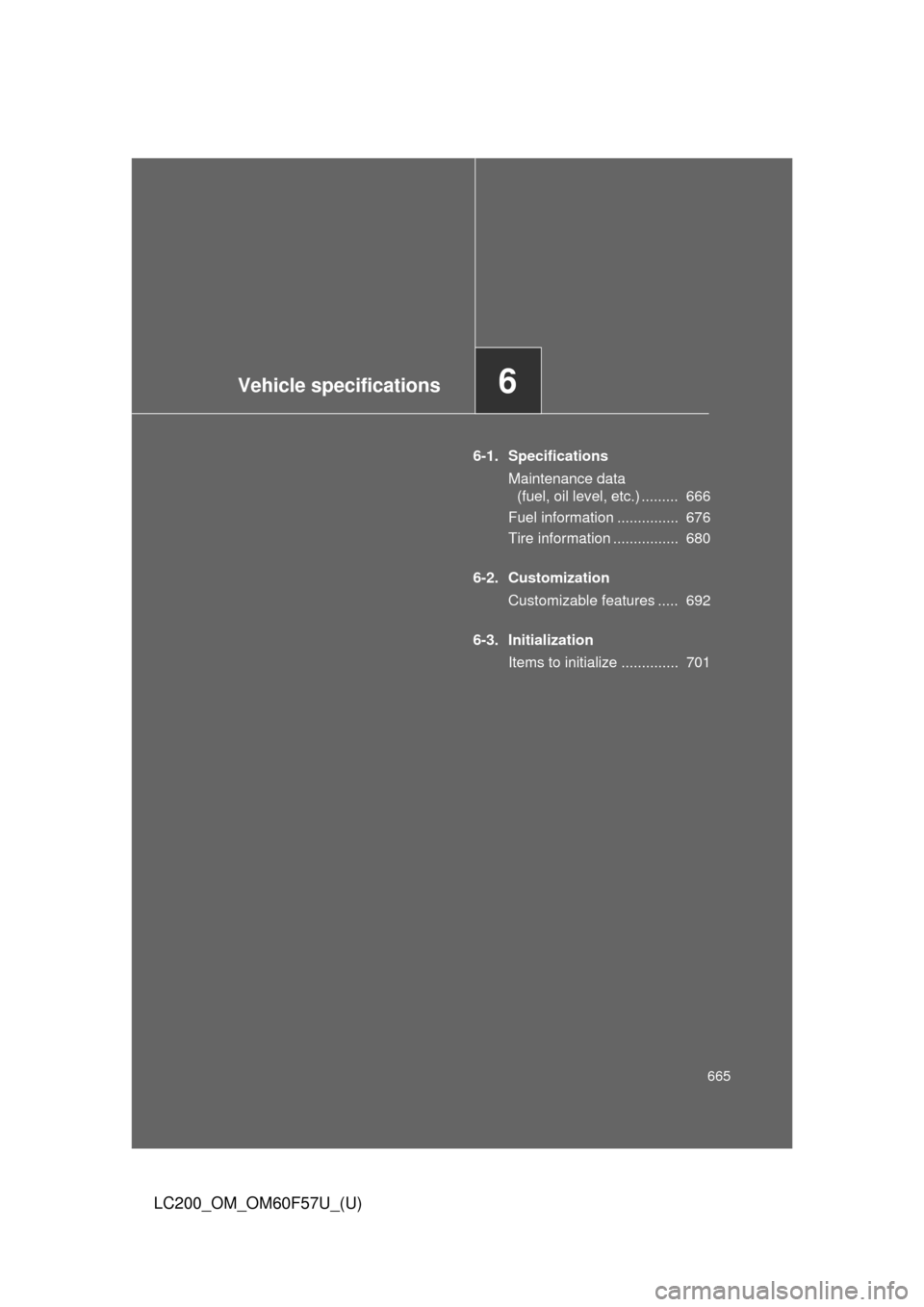
Vehicle specifications6
665
LC200_OM_OM60F57U_(U)
6-1. Specifications
Maintenance data
(fuel, oil level, etc.) ......... 666
Fuel information ............... 676
Tire information ................ 680
6-2. Customization
Customizable features ..... 692
6-3. Initialization
Items to initialize .............. 701
Page 666 of 720
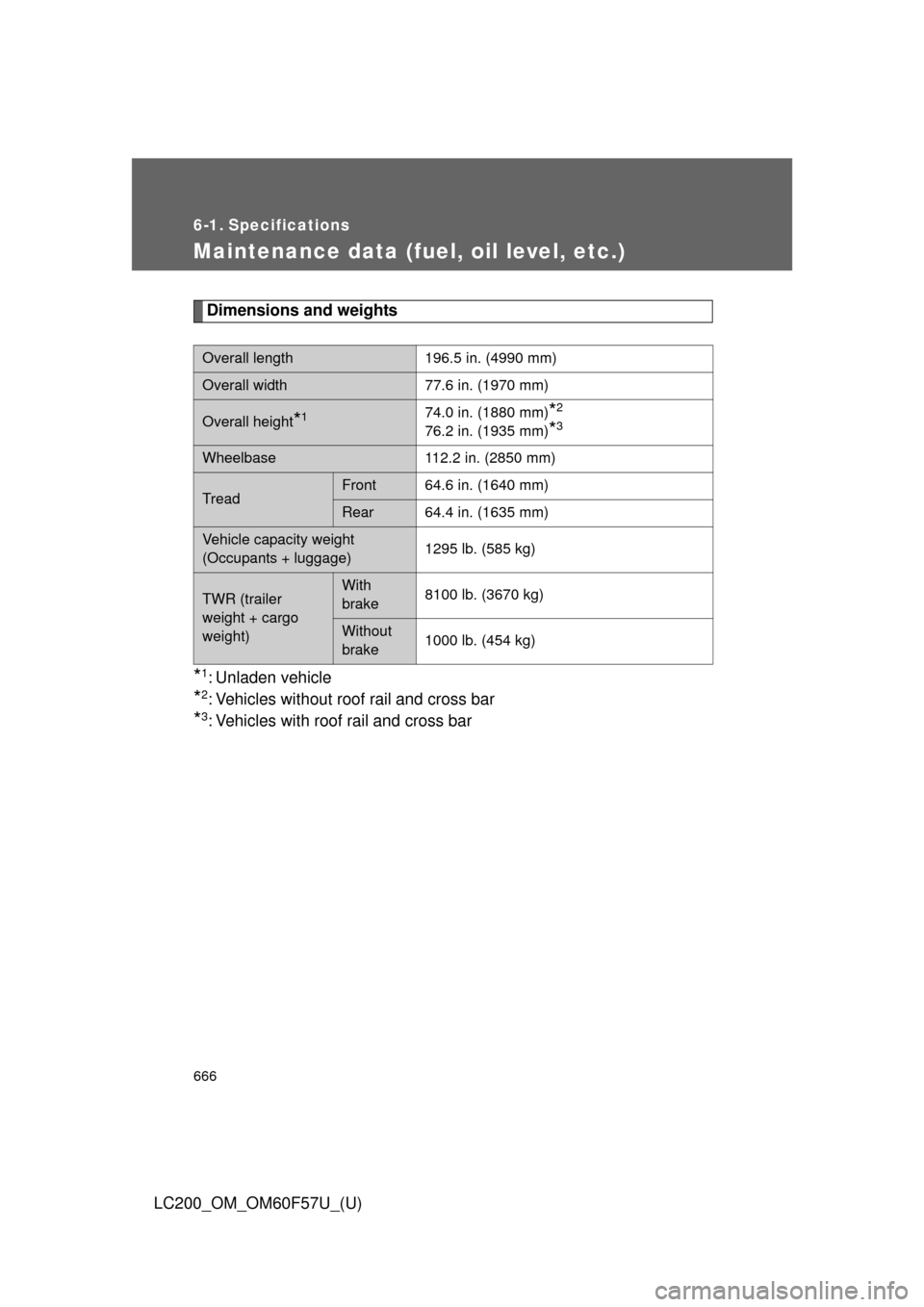
666
LC200_OM_OM60F57U_(U)
6-1. Specifications
Maintenance data (fuel, oil level, etc.)
Dimensions and weights
*1: Unladen vehicle
*2: Vehicles without roof rail and cross bar
*3: Vehicles with roof rail and cross bar
Overall length196.5 in. (4990 mm)
Overall width77.6 in. (1970 mm)
Overall height*174.0 in. (1880 mm)*2
76.2 in. (1935 mm)*3
Wheelbase112.2 in. (2850 mm)
TreadFront64.6 in. (1640 mm)
Rear64.4 in. (1635 mm)
Vehicle capacity weight
(Occupants + luggage)1295 lb. (585 kg)
TWR (trailer
weight + cargo
weight)With
brake8100 lb. (3670 kg)
Without
brake1000 lb. (454 kg)
Page 668 of 720
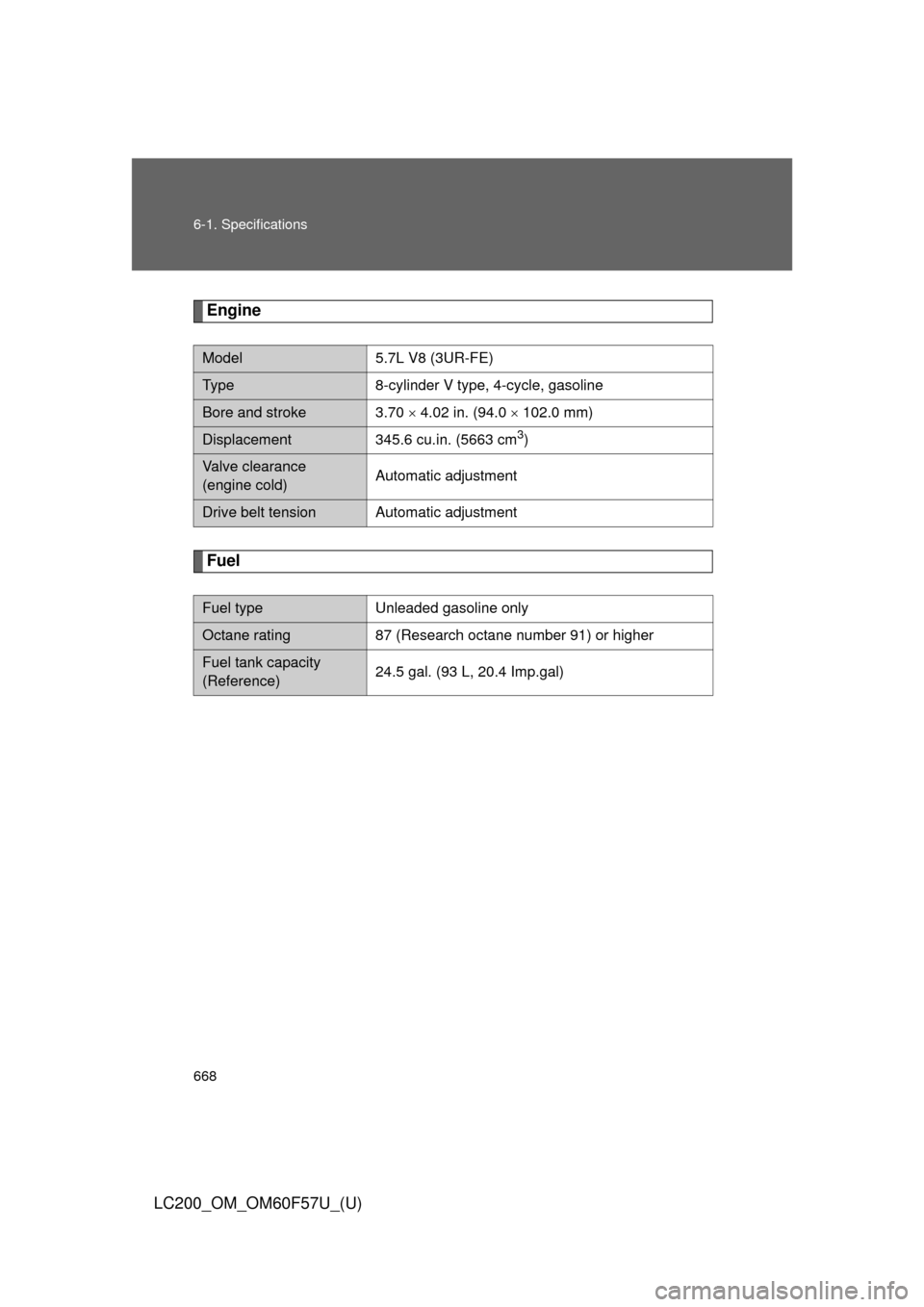
668 6-1. Specifications
LC200_OM_OM60F57U_(U)
Engine
Fuel
Model5.7L V8 (3UR-FE)
Ty p e8-cylinder V type, 4-cycle, gasoline
Bore and stroke3.70 4.02 in. (94.0 102.0 mm)
Displacement345.6 cu.in. (5663 cm3)
Valve clearance
(engine cold)Automatic adjustment
Drive belt tensionAutomatic adjustment
Fuel typeUnleaded gasoline only
Octane rating87 (Research octane number 91) or higher
Fuel tank capacity
(Reference)24.5 gal. (93 L, 20.4 Imp.gal)
Page 669 of 720
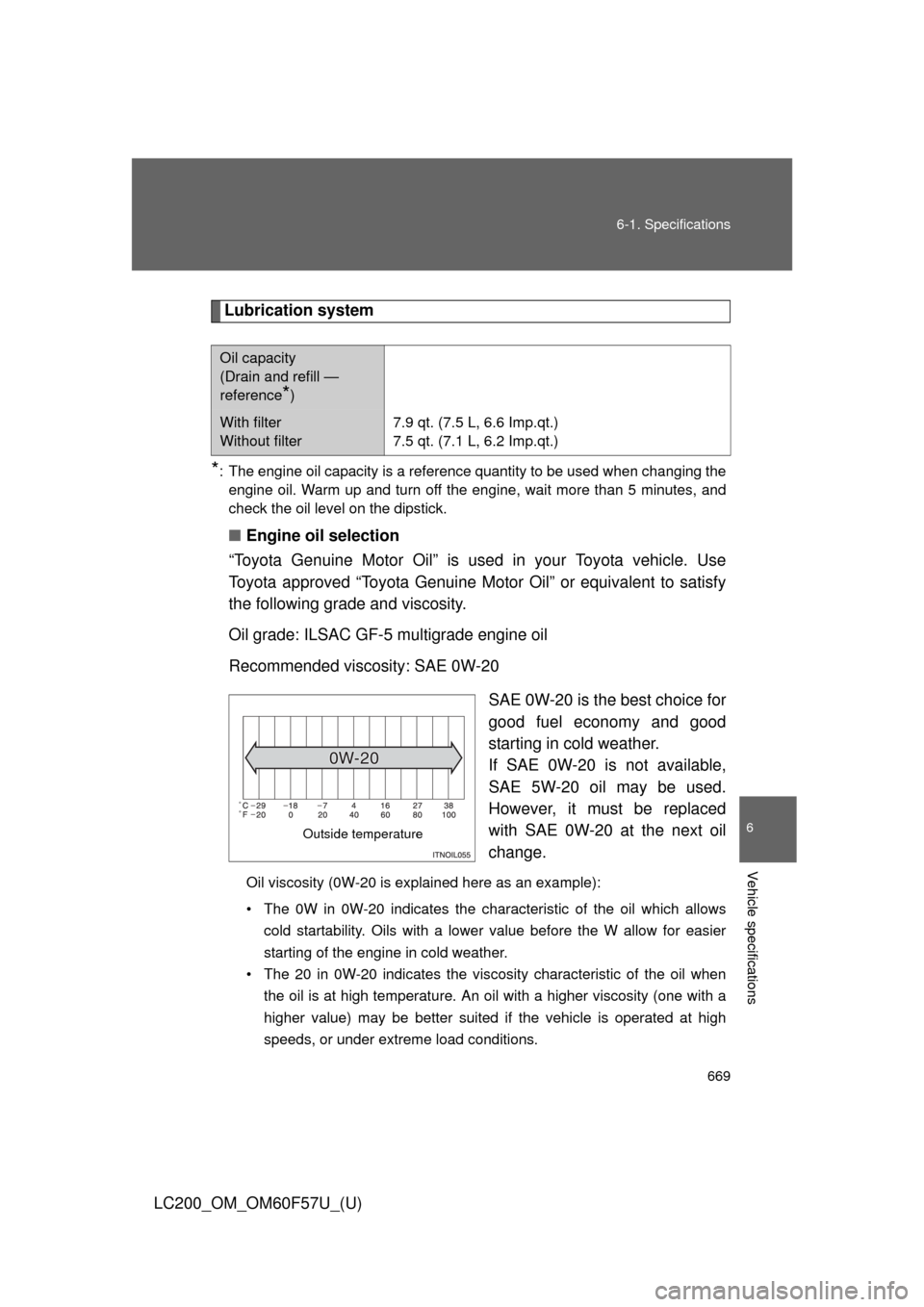
669 6-1. Specifications
6
Vehicle specifications
LC200_OM_OM60F57U_(U)
Lubrication system
*: The engine oil capacity is a reference quantity to be used when changing the
engine oil. Warm up and turn off the engine, wait more than 5 minutes, and
check the oil level on the dipstick.
■Engine oil selection
“Toyota Genuine Motor Oil” is used in your Toyota vehicle. Use
Toyota approved “Toyota Genuine Motor Oil” or equivalent to satisfy
the following grade and viscosity.
Oil grade: ILSAC GF-5 multigrade engine oil
Recommended viscosity: SAE 0W-20
SAE 0W-20 is the best choice for
good fuel economy and good
starting in cold weather.
If SAE 0W-20 is not available,
SAE 5W-20 oil may be used.
However, it must be replaced
with SAE 0W-20 at the next oil
change.
Oil viscosity (0W-20 is explained here as an example):
• The 0W in 0W-20 indicates the characteristic of the oil which allows
cold startability. Oils with a lower value before the W allow for easier
starting of the engine in cold weather.
• The 20 in 0W-20 indicates the viscosity characteristic of the oil when
the oil is at high temperature. An oil with a higher viscosity (one with a
higher value) may be better suited if the vehicle is operated at high
speeds, or under extreme load conditions.
Oil capacity
(Drain and refill —
reference
*)
With filter
Without filter7.9 qt. (7.5 L, 6.6 Imp.qt.)
7.5 qt. (7.1 L, 6.2 Imp.qt.)
Outside temperature
Page 676 of 720
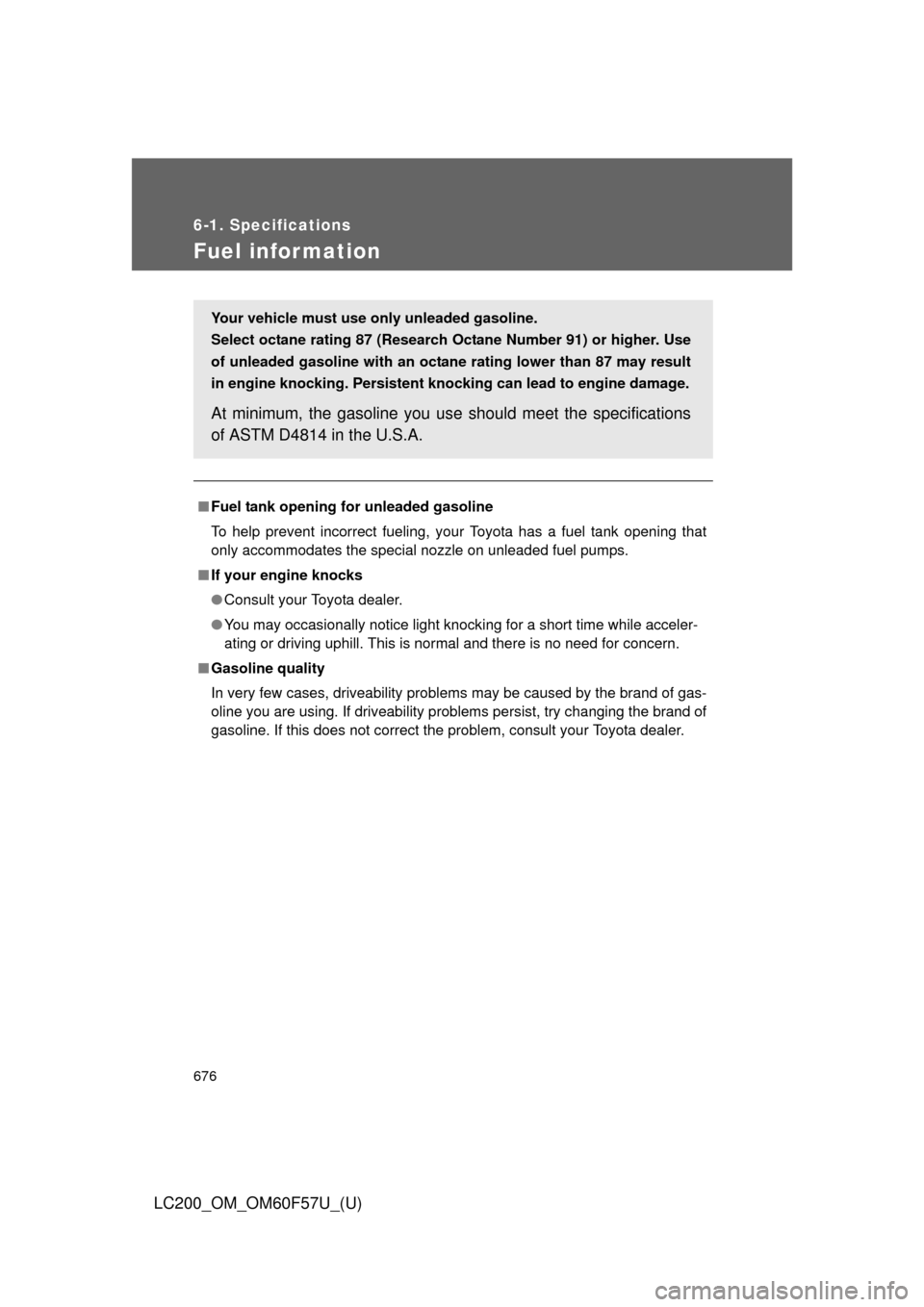
676
6-1. Specifications
LC200_OM_OM60F57U_(U)
Fuel infor mation
■Fuel tank opening for unleaded gasoline
To help prevent incorrect fueling, your Toyota has a fuel tank opening that
only accommodates the special nozzle on unleaded fuel pumps.
■If your engine knocks
●Consult your Toyota dealer.
●You may occasionally notice light knocking for a short time while acceler-
ating or driving uphill. This is normal and there is no need for concern.
■Gasoline quality
In very few cases, driveability problems may be caused by the brand of gas-
oline you are using. If driveability problems persist, try changing the brand of
gasoline. If this does not correct the problem, consult your Toyota dealer.
Your vehicle must use only unleaded gasoline.
Select octane rating 87 (Research Octane Number 91) or higher. Use
of unleaded gasoline with an octane rating lower than 87 may result
in engine knocking. Persistent knocking can lead to engine damage.
At minimum, the gasoline you use should meet the specifications
of ASTM D4814 in the U.S.A.